PRESS 2020
LA SEMAINE DU PAYS BASQUE (STÉPHANE MICOUD) 08/28/2020: READ AS PDF DOCUMENT DOWNLOAD HERE
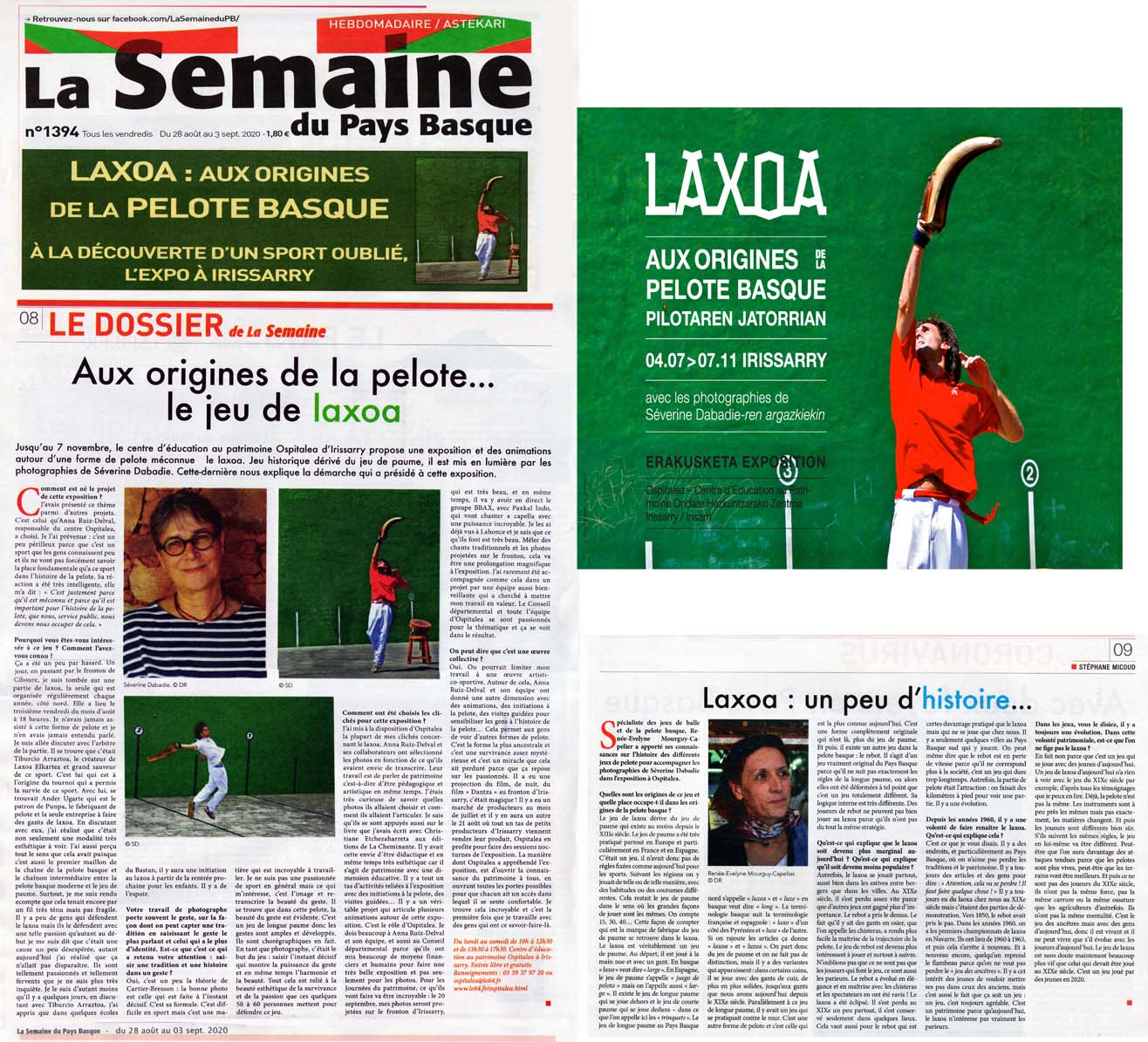
SUD-OUEST (FABIEN JANS) 07/11/2020: READ AS PDF DOCUMENT TO DOWNLOAD HERE
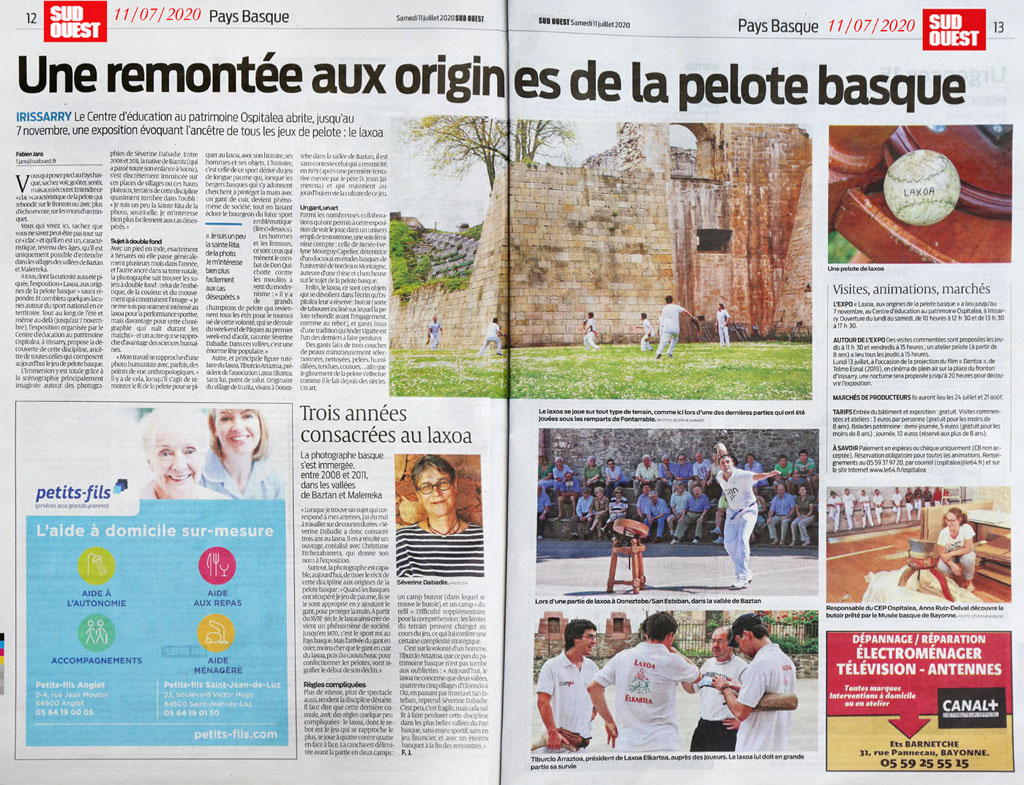
FRANCE 3 AQUITAINE JULY 2020
EUSKAL TELEBISTA 1: JULY 2020 (FRANCK DOLOSOR): IN BASQUE / EUSKARAZ
LA SEMAINE DU PAYS BASQUE : jan 2020
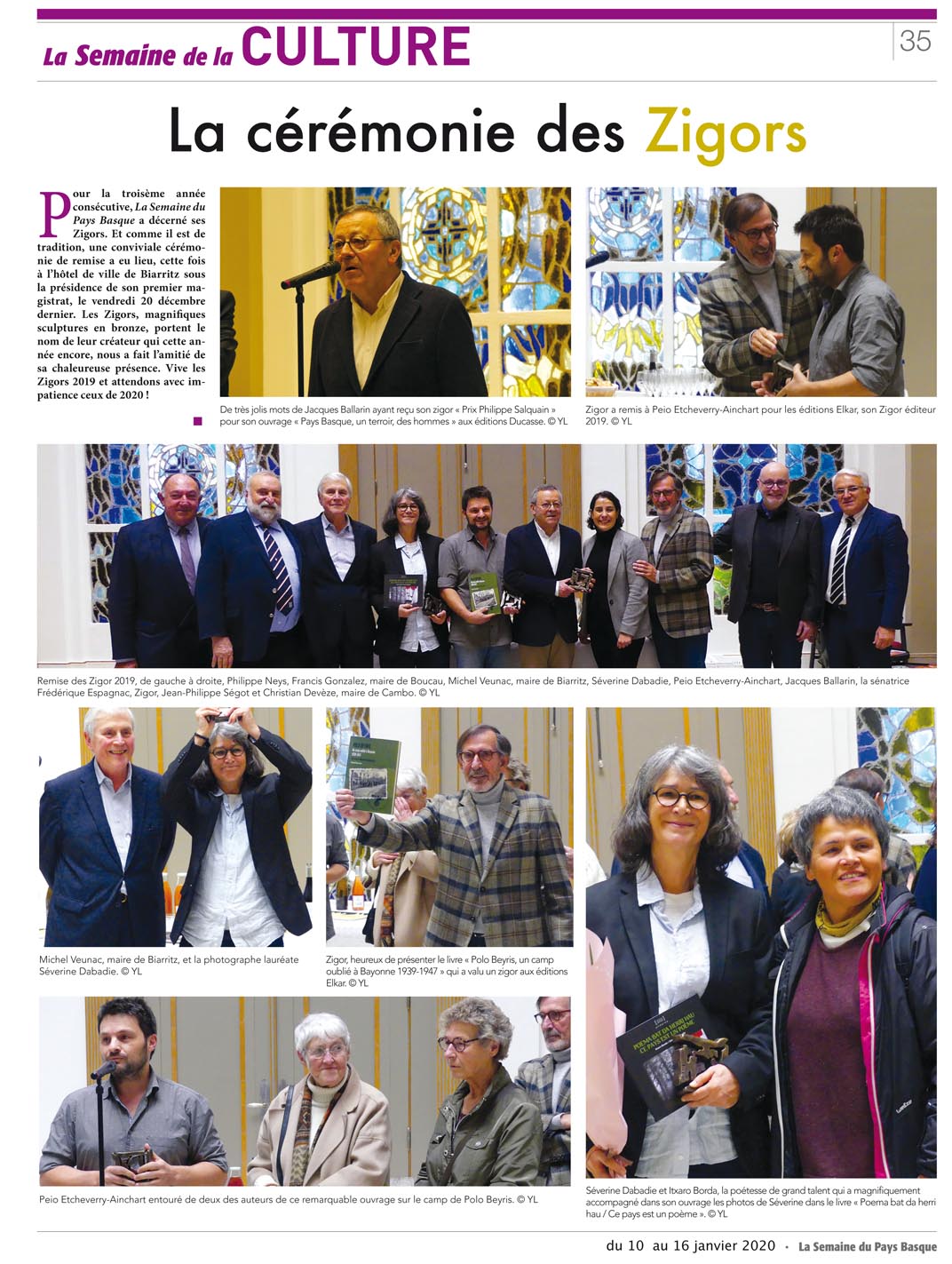
PRESS 2019
MEDIABASK DÉCEMBRE 2019
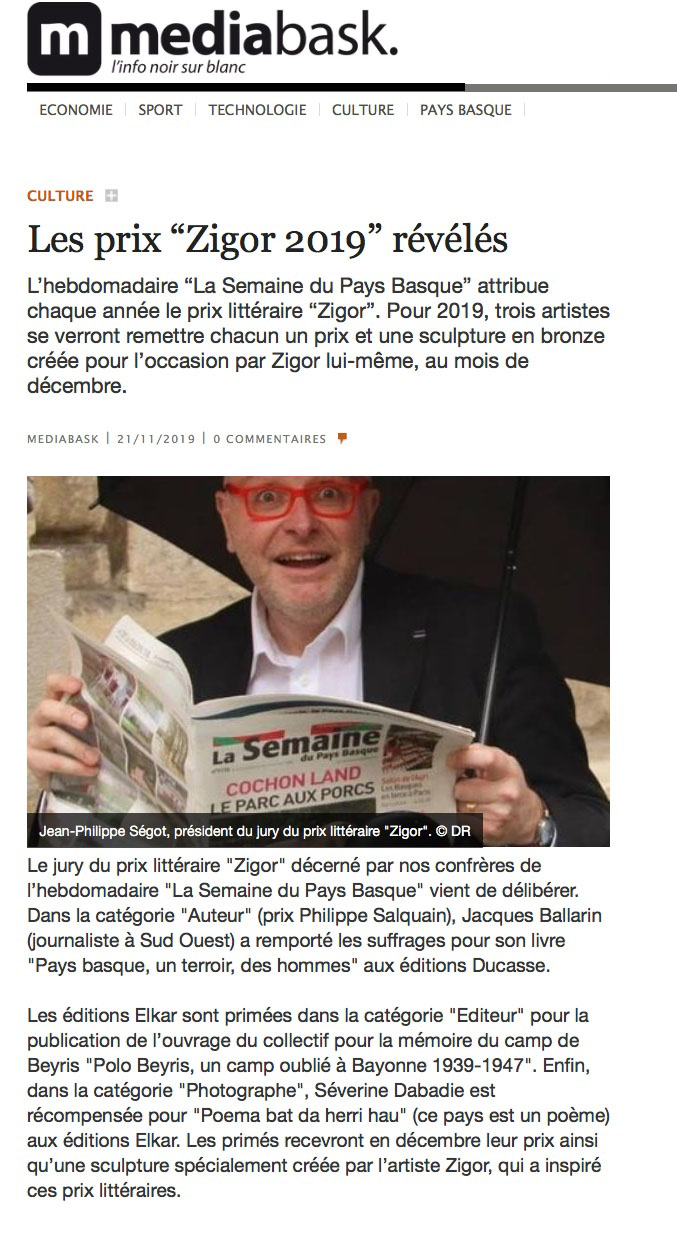
SUD-OUEST 16/12/2019

SUD-OUEST 05/12/2019
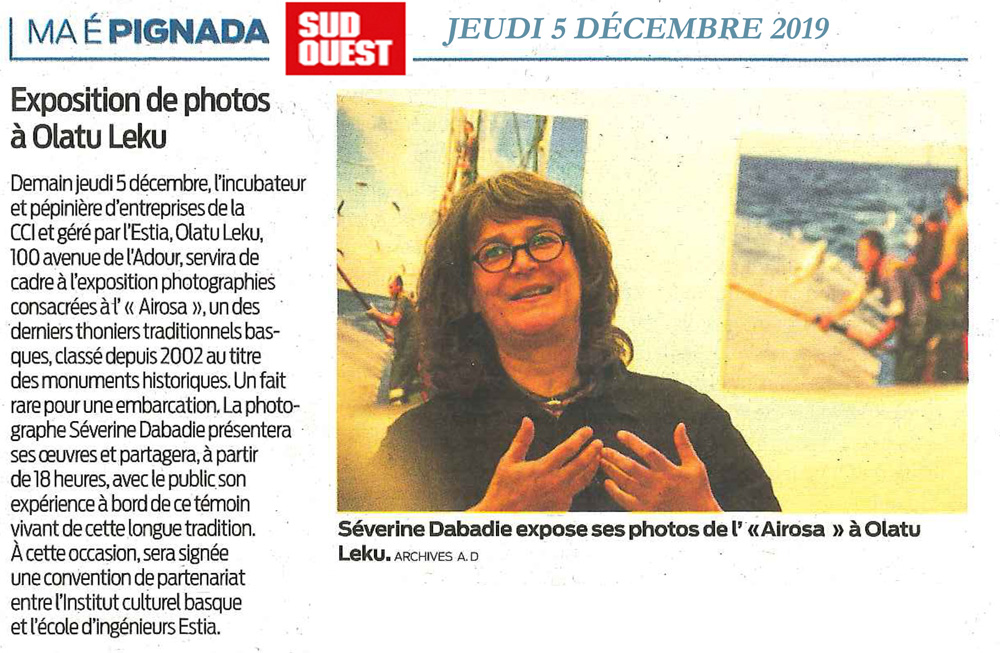
SUD-OUEST 09/11/2019: double-page
BERLIN 1989
Read the article HERE
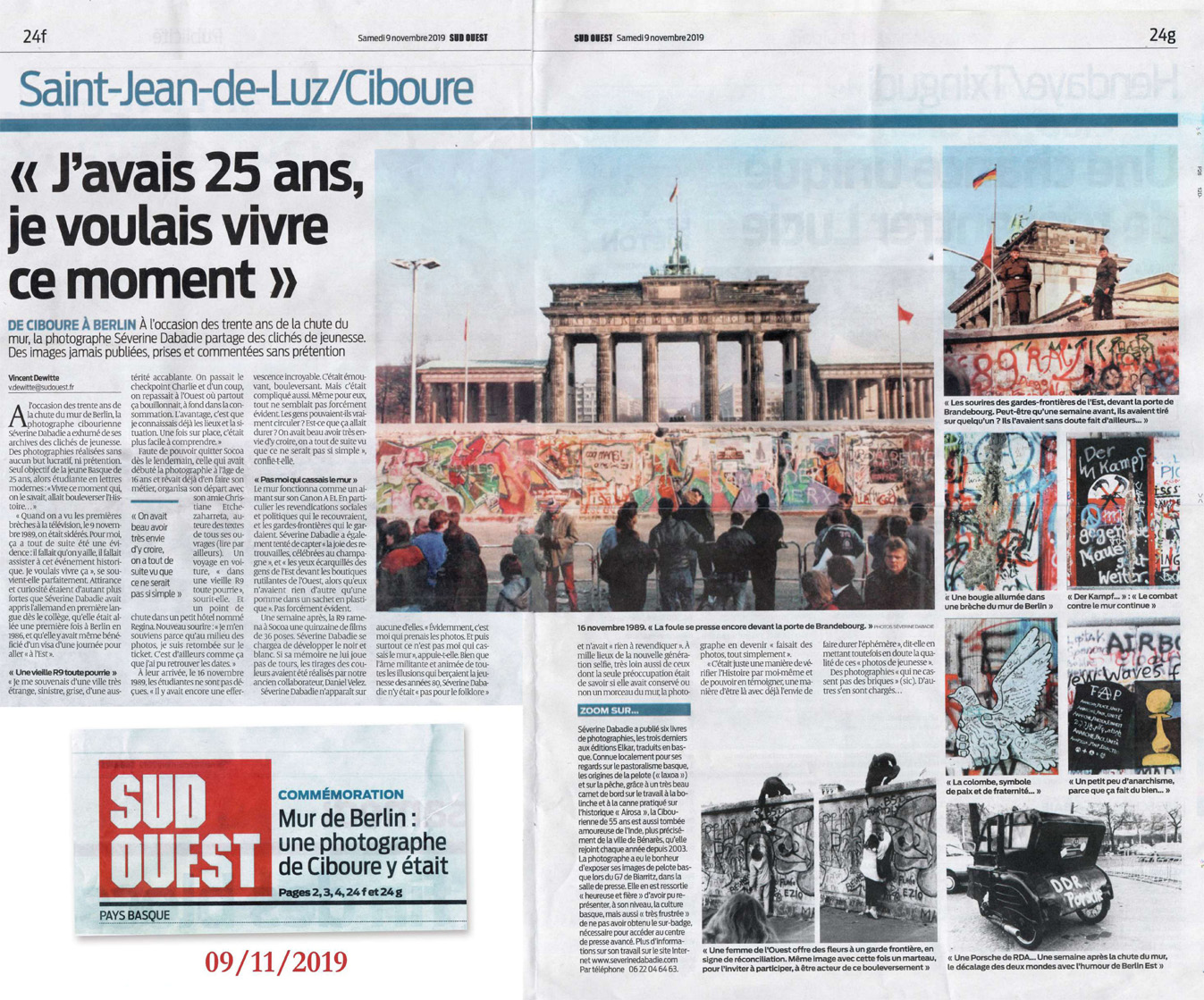
PATRIMOINE PAYS BASQUE & HISTORY (S) CURRENTLY AVAILABLE IN KIOSK
ABOUT SÉVERINE DABADIE: 4 PAGES, 1 INTERVIEW, PHOTOGRAPHS AND POEMS SIGNED ITXARO BORDA
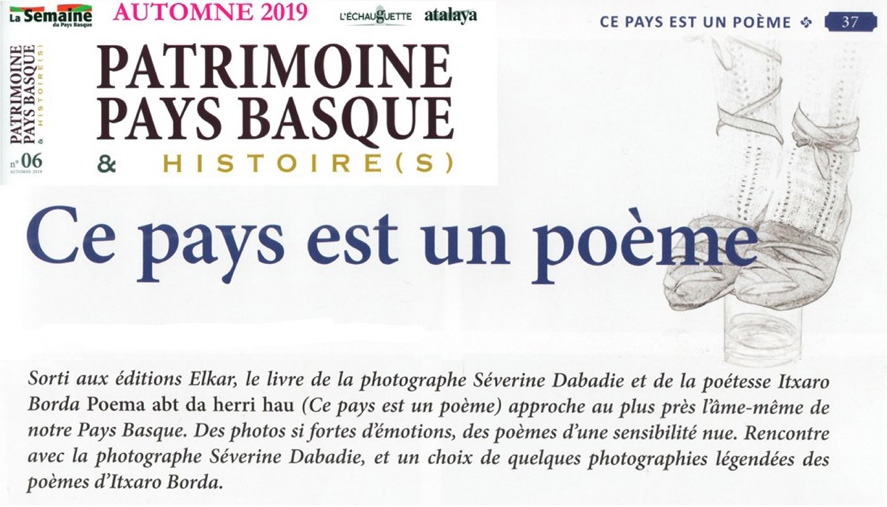
SUD-OUEST 21/08/2019
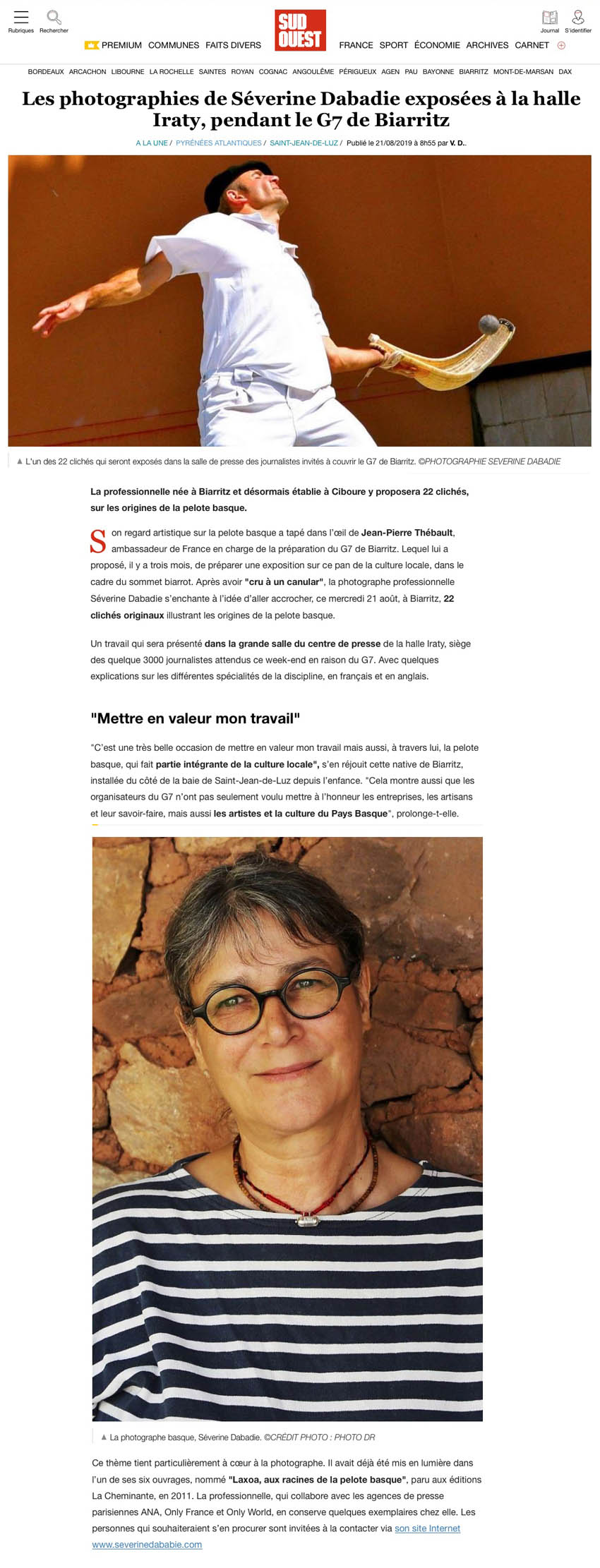
FRANCE 3 JOURNAL DE L'EUSKAL HERRI
Reportage Sabrina Corrieri © S. Corrieri-France3

Radio Kultura
Interview with Itxaro Borda and Séverine Dabadie on december 2018

To listen the programm, please click HERE
Le Courrier français 15 mars
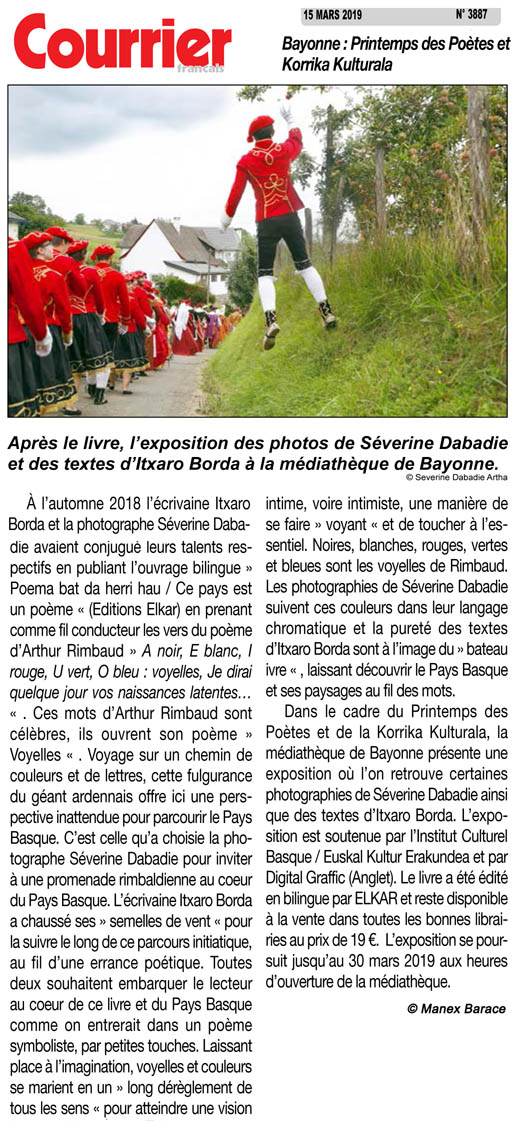
Semaine du Pays Basque du 8 au 15 mars 2019

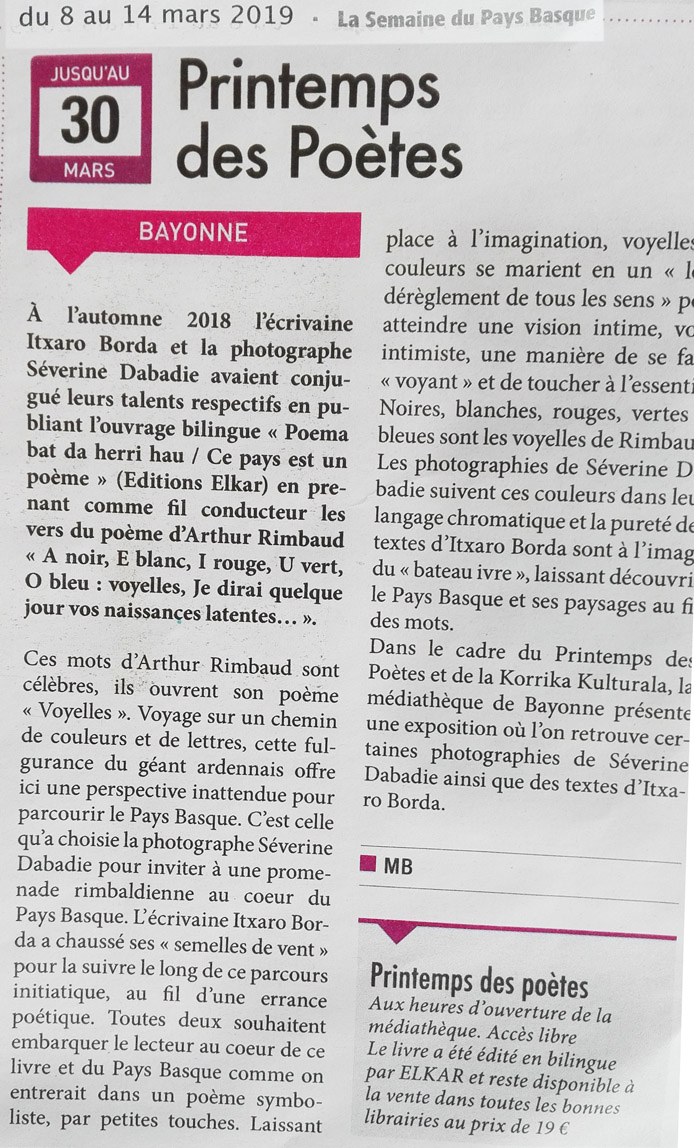
PRESS 2018
14/12/2018
Press Emmanuelle Fère ©
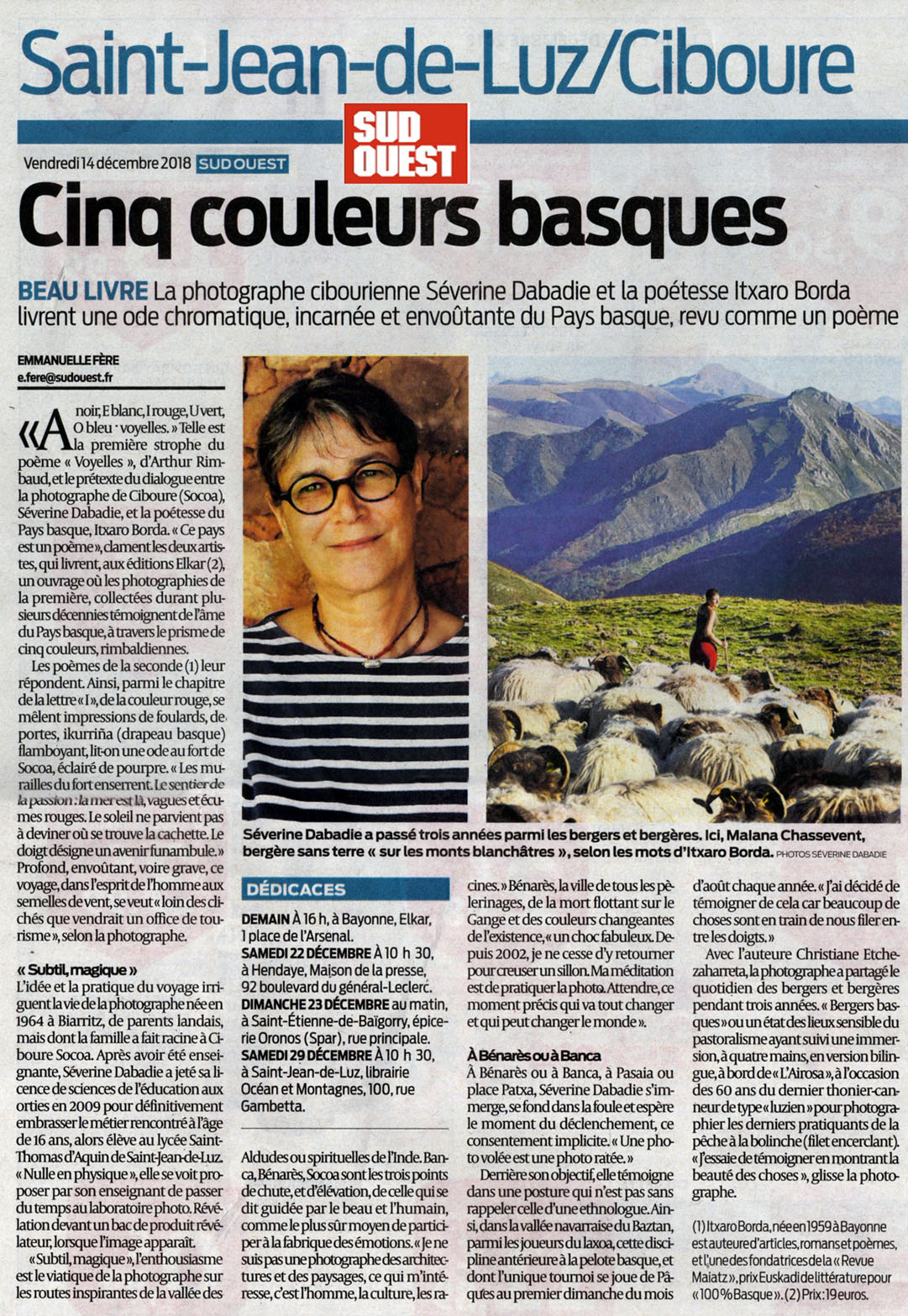
29/11/2018
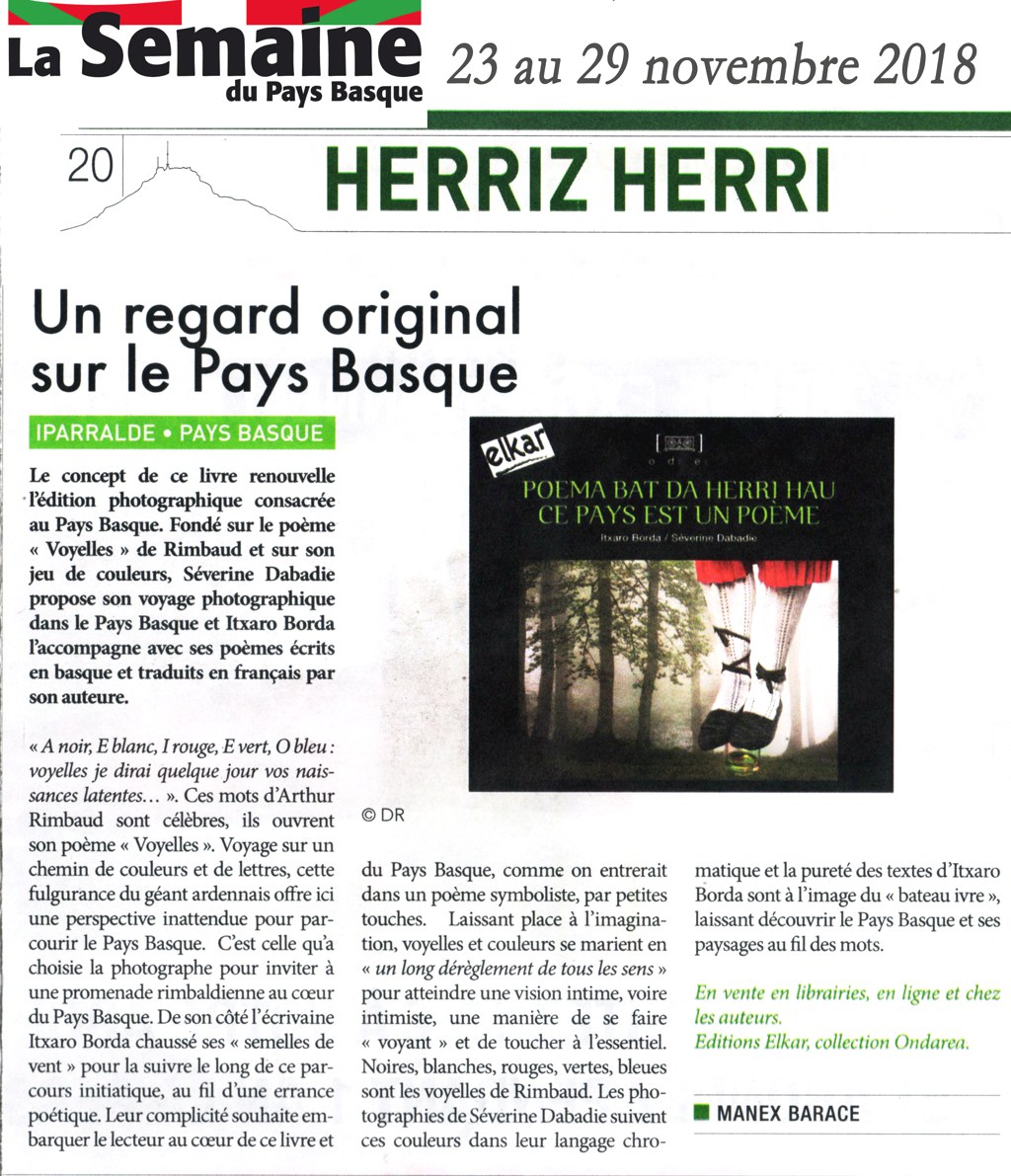

03/04/2018
Download HERE
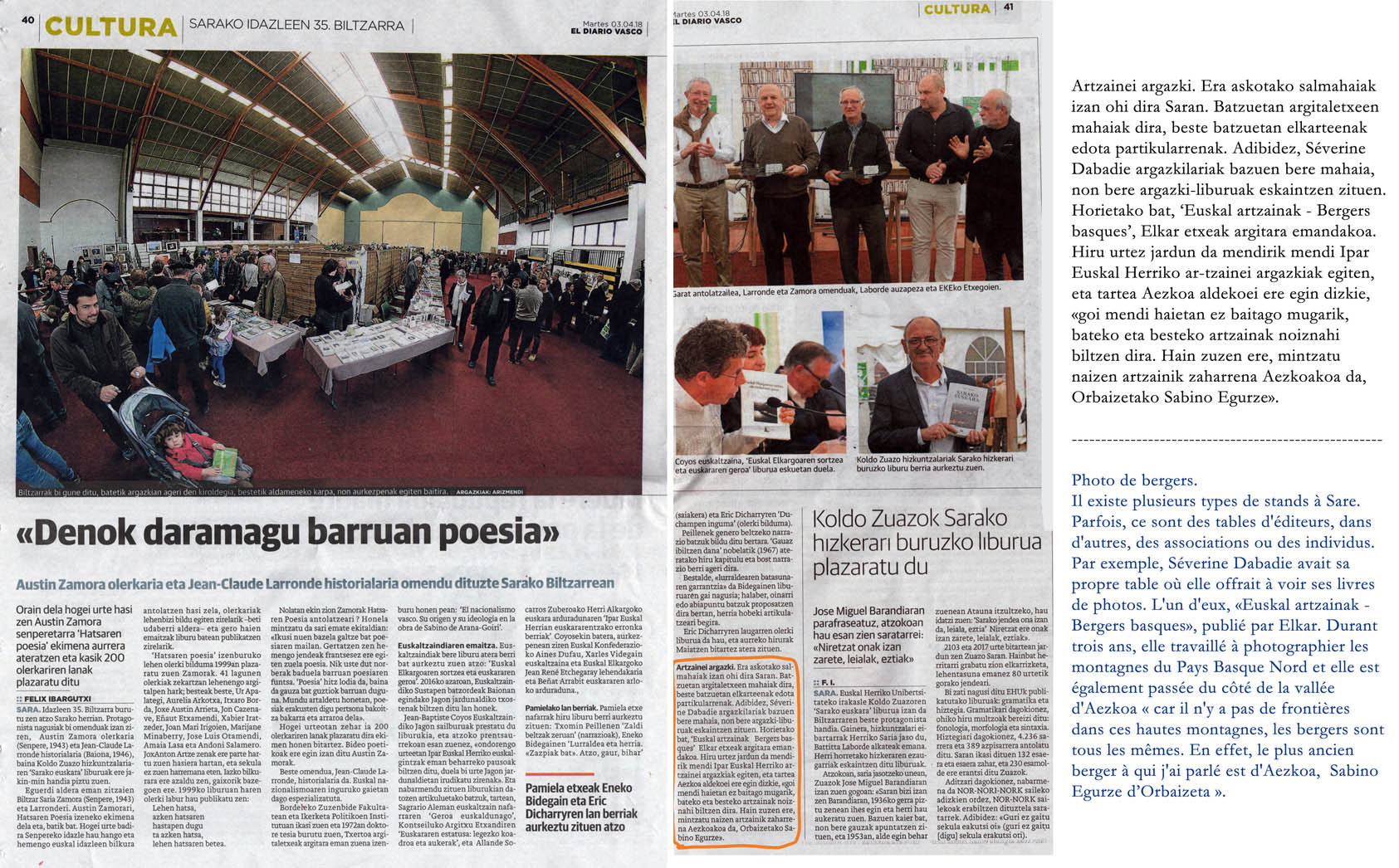
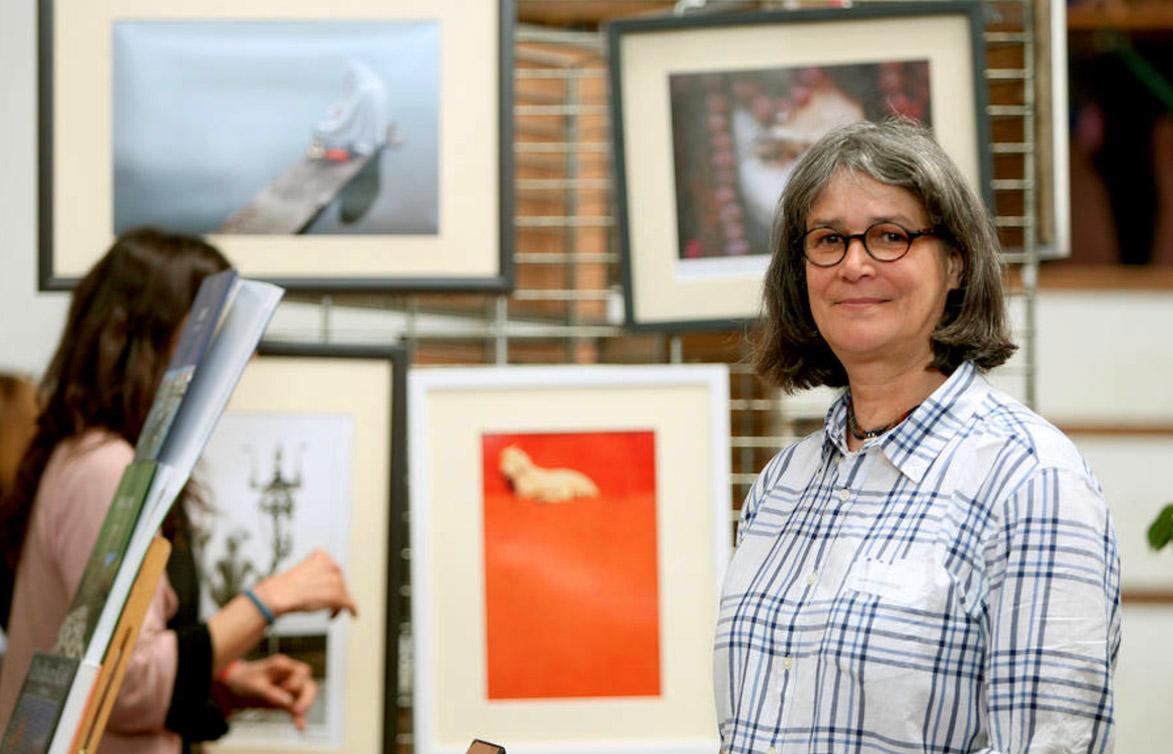
© Arizmendi - Diario Vasco - 2018
PRESS 2017

France Bleu pays Basque © october 2017
Play HERE
2 minutes. Interview with Olivier Vinches
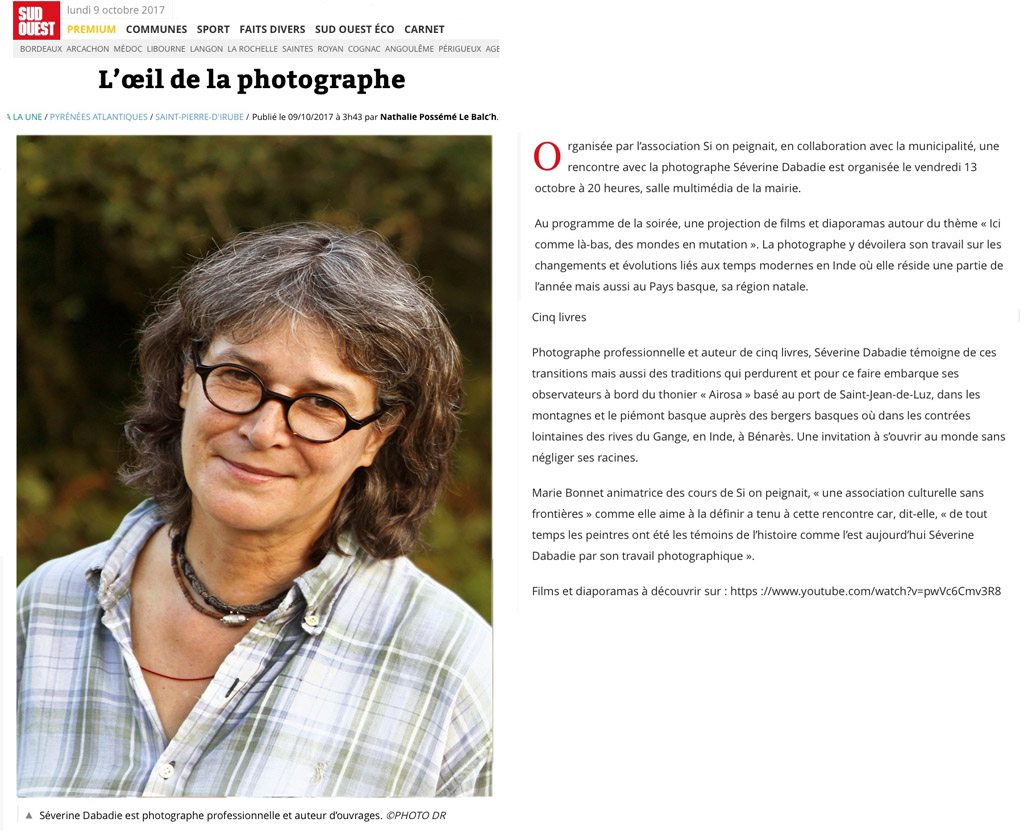
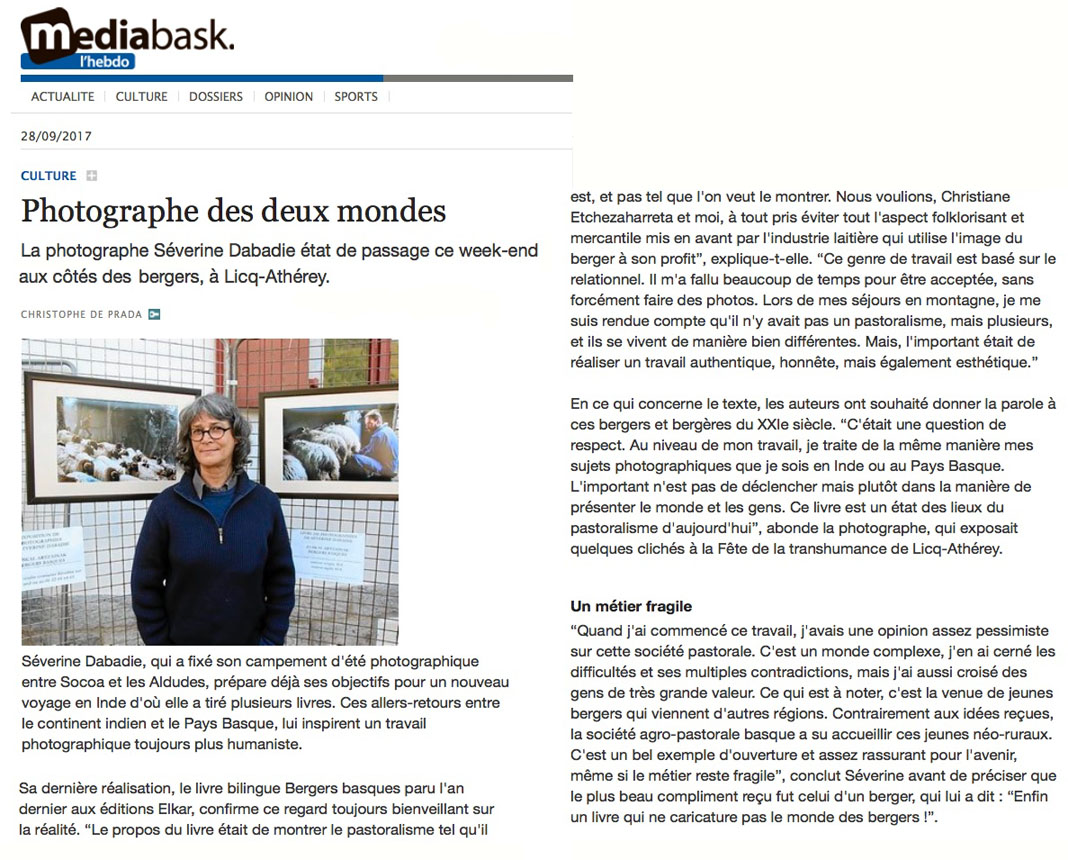

20th January 2017
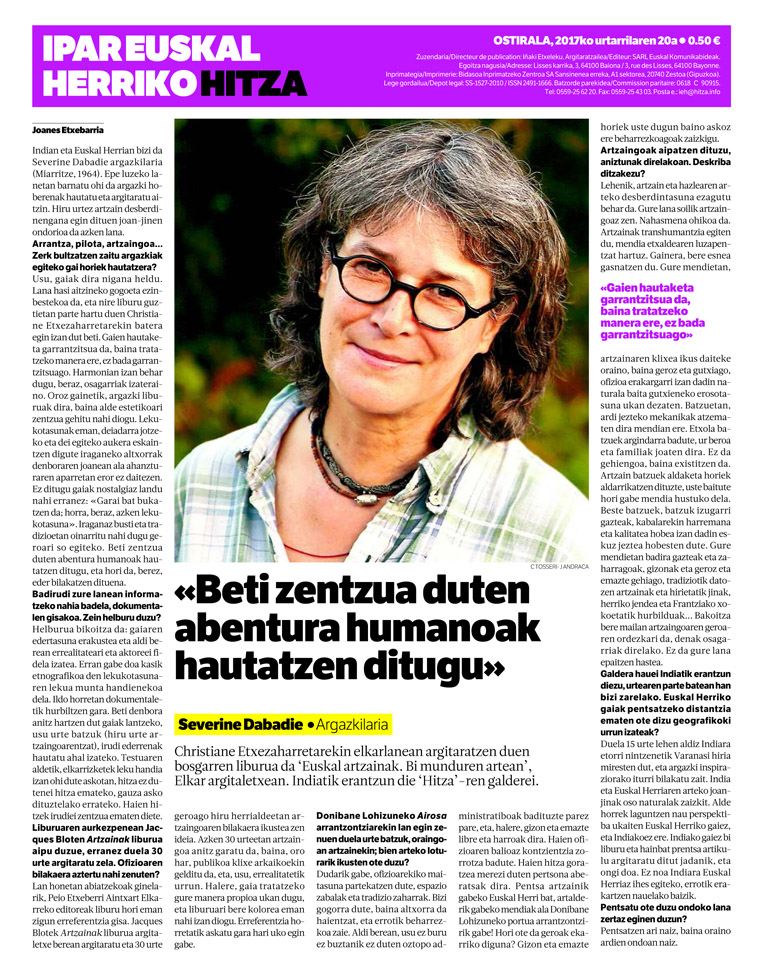
« Beti zentzua duten abentura humanoak hautatzen ditugu »
Joanes Etxebarria :
Severine Dabadie Argazkilaria
Christiane Etxezaharretarekin elkarlanean argitaratzen duen bosgarren liburua da « Euskal artzainak. Bi munduren artean » Elkar argitaletxean. Indiatik erantzun die ‘Hitza’-ren galderei.
Indian eta Euskal Herrian bizi da Severine Dabadie argazkilaria (Miarritze, 1964). Epe luzeko lanetan barnatu ohi da argazki hoberenak hautatu eta argitaratu aitzin. Hiru urtez artzain desberdinengana egin dituen joan-jinen ondorioa da azken lana.
Arrantza, pilota, artzaingoa... Zerk bultzatzen zaitu argazkiak egiteko gai horiek hautatzera?
Usu, gaiak dira nigana heldu. Lana hasi aitzineko gogoeta ezinbestekoa da, eta nire liburu guztietan parte hartu duen Christiane Etxezaharretarekin batera egin izan dut beti. Gaien hautaketa garrantzitsua da, baina tratatzeko manera ere, ez bada garrantzitsuago. Harmonian izan behar dugu, beraz, osagarriak izateraino. Oroz gainetik, argazki liburuak dira, baina alde estetikoari zentzua gehitu nahi diogu. Lekukotasunak eman, deiadarra jotzeko eta dei egiteko aukera eskaintzen
digute iraganeko altxorrak denboraren joanean ala ahanzturaren aparretan eror ez daitezen. Ez ditugu gaiak nostalgiaz landu nahi erranez: « Garai bat bukatzen da; horra, beraz, azken lekukotasuna ». Iraganaz busti eta tradizioetan oinarritu nahi dugu geroari so egiteko. Beti zentzua duten abentura humanoak hautatzen ditugu, eta hori da, berez, eder bilakatzen dituena.
Badirudi zure lanean informatzeko nahia badela, dokumentalen gisakoa. Zein helburu duzu?
Helburua bikoitza da: gaiaren edertasuna erakustea eta aldi berean errealitateari eta aktoreei fidela izatea. Erran gabe doa kasik etnografikoa den lekukotasunaren lekua munta handienekoa dela. Ildo horretan dokumentaletik hurbiltzen gara. Beti denbora anitz hartzen dut gaiak lantzeko, usu urte batzuk (hiru urte artzaingoarentzat), irudi ederrenak hautatu ahal izateko. Testuaren aldetik, elkarrizketek leku handia izan ohi dute askotan, hitza ez dutenei hitza emateko, gauza asko dituztelako errateko. Haien hitzek irudiei zentzua ematen diete.
Liburuaren aurkezpenean Jacques Bloten Artzainak liburua aipu duzue, erranez duela 30 urte argitaratu zela. Ofizioaren bilakaera aztertu nahi zenuten?
Lan honetan abiatzekoak ginelarik, Peio Etxeberri Aintxart Elkarreko editoreak liburu hori eman zigun erreferentzia gisa. Jacques Blotek Artzainak liburua argitaletxe berean argitaratu eta 30 urte geroago hiru herrialdeetan artzaingoaren bilakaera ikustea zen ideia. Azken 30 urteetan artzaingoa anitz garatu da, baina, oro har, publikoa klixe arkaikoekin gelditu da, eta, usu, errealitatetik urrun. Halere, gaia tratatzeko gure manera propioa ukan dugu, eta liburuari bere kolorea eman nahi izan diogu. Erreferentzia horretatik askatu gara hari uko egin gabe.
Donibane Lohizuneko Airosa arrantzontziarekin lan egin zenuen duela urte batzuk, oraingoan artzainekin; bien arteko loturarik ikusten ote duzu?
Dudarik gabe, ofizioarekiko maitasuna partekatzen dute, espazio zabalak eta tradizio zaharrak. Bizi gogorra dute, baina altxorra da haientzat, eta errotik beharrezkoa zaie. Aldi berean, usu ez buru ez buztanik ez duten oztopo administratiboak badituzte parez pare, eta, halere, gizon eta emazte libre eta harroak dira. Haien ofizioaren balioaz kontzientzia zorrotza badute. Haien hitza goratzea merezi duten pertsona aberatsak dira. Pentsa artzainik gabeko Euskal Herri bat, artalderik gabeko mendiak ala Donibane Lohizuneko portua arrantzontzirik gabe! Hori ote da geroak ekarriko diguna? Gizon eta emazte horiek uste dugun baino askoz ere beharrezkoagoak zaizkigu.
« Gaien hautaketa garrantzitsua da, baina tratatzeko manera ere, ez bada garrantzitsuago »
Artzaingoak aipatzen dituzu, aniztunak direlakoan. Deskriba ditzakezu?
Lehenik, artzain eta hazlearen arteko desberdintasuna ezagutu behar da. Gure lana soilik artzaingoaz zen. Nahasmena ohihasteakoa da. Artzainak transhumantzia egiten du, mendia etxaldearen luzapentzat hartuz. Gainera, bere esnea gasnatzen du. Gure mendietan, artzainaren klixea ikus daiteke oraino, baina geroz eta gutxiago, ofizioa erakargarri izan dadin naturala baita gutxieneko erosotasuna ukan dezaten. Batzuetan, ardi jezteko mekanikak atzematen dira mendian ere. Etxola batzuek argindarra badute, ur beroa eta familiak joaten dira. Ez da gehiengoa, baina existitzen da. Artzain batzuek aldaketa horiek aldarrikatzen dituzte, uste baitute hori gabe mendia hustuko dela. Beste batzuek, batzuk izugarri gazteak, kabalarekin harremana eta kalitatea hobea izan dadin eskuz jeztea hobesten dute. Gure mendietan badira gazteak eta zaharragoak, gizonak eta geroz eta emazte gehiago, tradiziotik datozen artzainak eta hirietatik jinak, herriko jendea eta Frantziako xokoetatik hurbilduak... Bakoitza bere mailan artzaingoaren geroaren ordezkari da, denak osagarriak direlako. Ez da gure lana epaitzen hastea.
Galdera hauei Indiatik erantzun diezu, urtearen parte batean han bizi zarelako. Euskal Herriko gaiak pentsatzeko distantzia ematen ote dizu geografikoki urrun izateak?
Duela 15 urte lehen aldiz Indiara etorri nintzenetik Varanasi hiria miresten dut, eta argazki inspiraziorako iturri bilakatu zait. India eta Euskal Herriaren arteko joanjinak oso naturalak zaizkit. Alde horrek laguntzen nau perspektiba ukaiten Euskal Herriko gaiez, eta Indiakoez ere. Indiako gaiez bi liburu eta hainbat prentsa artikulu argitaratu ditut jadanik, eta ongi doa. Ez noa Indiara Euskal Herriaz ihes egiteko, errotik erakartzen nauelako baizik.
Pentsatu ote duzu ondoko lana zertaz eginen duzun?
Pentsatzen ari naiz, baina oraino ardien ondoan naiz.
Translation
We always select subject of human adventure which make sense
Joanes Etxebarria:
Severine Dabadie Photographer
It is the fifth book published in cooperation with Christiane Etxezaharreta "Basque shepherds. Between two worlds "publishing each other. India responded 'Hitza''s questions.
Indian and lived in the Basque Country's Severine Dabadie photographer (Biarritz, 1964). Profound long-term work is usually best to select and publish the photos before. Three years to the different pastors to-come is the result of the latest work.
Fishing, shepherds ... What inspires you to select those capable of taking pictures?
Often, the issues come to me. It is essential to reflect before starting work, and in all my books, I have participated with Christiane Etxezaharreta always. It is important for the selection of themes, but also a way to treat, if not more important. We need to be in harmony, so as to accessories. Above all, of the books, but we want to add to the sense of aesthetic. The testimonies, cry and call options for providing access
Treasures from the past or forgetting us over time to avoid falling into the foam. We do not want to deal with issues of nostalgia, saying: "It's the end of an era; Behold, then, the testimony. " We want to expose based on the traditions of the past and the future do so. Always select the human sense of adventure that we have, and that is, in itself, is a beautiful.
It seems that there is a desire to inform your work, like documentaries. What are you goals?
The purpose is twofold: to show the beauty of the subject and at the same time being faithful to reality and actors. It goes without saying that it is of the greatest importance to the testimony of an almost ethnographic. In this regard we are closer to the documentary. I always take a lot of time to work on things, often a few years (three years shepherds), in order to select the most beautiful image. The text, they tend to be high in many conversations, word for word to those who do not, they say a lot of things. Their words give meaning to the images.
Jacques Blot Shepherds presentation of the book, you quote the book, saying that it was published 30 years ago. Did you want to analyze the evolution of the office?
In this work we were to start, Peio Etxeberri Aintxart joint editors gave us this book as a reference. Jacques Blot shepherd the publishers of the book, published 30 years later, the idea was to see the three countries of the shepherds. In the last 30 years has developed a wide range of shepherds, but, in general, the public is left archaic cliché, and, often, far from reality. However, the treatment of the subject, we have our own way, and we wanted to give the book its color. In this reference, we release it without sacrificing.
Saint Jean de Luz Airosa fishing you have to work a few years ago, this time the shepherds; You could see the connection between the two?
Without doubt, they share a love ofizioarekiko, open spaces and old traditions. They have a hard life, but it is a treasure for them, and they need to root. At the same time, often do not have no head nor tail of administrative obstacles in front of them, and, yet, men and women are free and proud. If the sharp awareness of the value of their profession. The lifting of the word of the person who deserves to be rich. Think of a Basque Country without a shepherd, sheep or the mountains of the port of Saint Jean de Luz with a fishing boat! Is this the future bring us? These men and women are more necessary than we think.
"It is important that the selection of subject matter, but also a way to treat, if not more important"
Shepherd life you're talking about, they are multiple. You can describe?
First, one must know the difference between a shepherd and breeders. Our job was only shepherds. Ohihasteakoa is confusion. The transhumance shepherds, as an extension of the mountain estate. In addition, the gasnatzen their milk. Our mountains, shepherd cliché can be seen yet, but more and more with less, to trade natural attractions as well as to have a minimum level of comfort. Sometimes, sheep milking mechanics are captured in the mountains. Some huts have electricity, hot water and they go to the families. It is not a majority, but it exists. Some pastors have enacted these changes, because they believe that no mountain is empty. Others, some very young, and the poor quality of the relationship to be better to hand-milking preferred. Our mountains are young and older, men and women more and more, from tradition shepherds and brothers in the cities, the people and the French approximate corner ... Each level is representative of the future shepherds, all of them are complementary. It is not our job to judge.
You answer these questions from India, a part of the year because you live there. It allows you to think about the issues of the Basque Country in the distance being geographically far?
I come to India for the first time in 15 years that I admire the city Varanasi, and become a source of inspiration to me. India and the Basque Country between joanjinak very natural to me. This perspective helps me to hold for the subjects of the Basque Country, and in India. India issues two books and numerous press articles have already been published, and it goes well. I'm not going to India to escape the Basque Country, but the root attracts me.
You have to think about the work you do?
I'm thinking, but I'm still with sheeps.
------------------ ------------------ ------------------ ------------------ ------------------ ------------------ ------------------

MAGAZINE OF THE BASQUE COUNTRY DEDICATED TO SÉVERINE DABADIE: SATURDAY 7 JANUARY AT 7:10 PM ON FRANCE 3 AQUITAINE
Reportage France 3 Aquitaine © by Perrine Durandeau (journalist) and Rémi Poissonnier (camera)
With Séverine Dabadie (photographer), Jean-Bernard Maitia and Maina Chassevent (shepherds), Didier Martinez (patron fisherman on the Airosa), Punpa
A meeting now in the framework of our magazine of the Basque Country with a young woman, Séverine Dabadie. Native of Ciboure, the photo quickly imposed itself as an obvious. A sensitization in high school with the image revealed in the lab .. A reflex always in the hand, it surveys the country in search of the time that goes, the "always" as she says: shepherds, fishermen, pelotaris, She crunches thoroughly and immerses herself in the environment, for a long time, sometimes several years. This gives rise to photojournalism, realistic, raw, pure, sincere in all cases.
In the style of the new journalism dear to the American Tom Wolfe in the 60s, it lives with the communities it seizes .. oscillating between India and the Basque Country.
Basco Indian, his look is disheveled.
Un encuentro en esta parte de la revista del País Vasco con una mujer joven, Séverine Dabadie. Un nativo de Ciboure, la fotografía se ha convertido rápidamente muy claro. El conocimiento en la escuela secundaria con la imagen revelada en el laboratorio .. Un reflejo todavía en la mano, que marca el ritmo del país en busca de la línea de tiempo, los oficios "siempre" como ella dijo, pastores, pescadores, la pelota vasca, cruje a fondo y se sumergió en el medio, largo tiempo, a veces años. Esto se traduce en el fotoperiodismo, realista, crudo, puro, sincero en todos los casos.
A la manera de nuevo periodismo caro en el estadounidense Tom Wolfe en los años 60, vive con las comunidades en las que entra .. oscilantes entre la India y el País Vasco.
------------------ ------------------ ------------------ ------------------ ------------------ ------------------ ------------------
 Français
Français English
English Espanol
Espanol